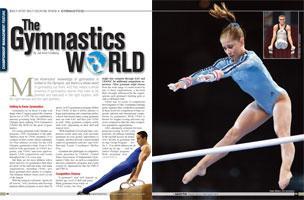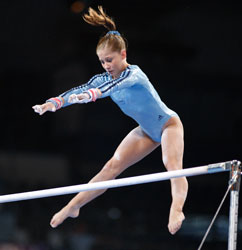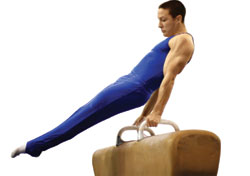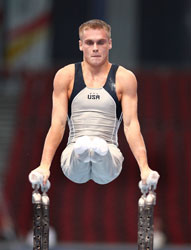
Most Americans' knowledge of gymnastics is limited to the Olympics, but there's a whole world of gymnastics out there. And that means a whole universe of gymnastics events that have to be planned and executed in the right location, with the right venues and the right partners.
Getting to Know Gymnastics
Gymnastics as we know it today took shape when Congress passed the Amateur Sports Act of 1978. The Act established a national governing body (NGB)for each Olympic sport, making UGA Gymnastics (USAG) the NGB for the sport of gymnastics.
 For young gymnasts with Olympic aspirations, USA Gymnastics is the path. Athletes must be USAG members of to compete in their events, which culminate, for Elite athletes, in trials for the USA Olympic gymnastics team. Four to five million kids participate in USAG programs, and USAG sanctions approximately 3,500 competitions and events throughout the U.S. every year.
For young gymnasts with Olympic aspirations, USA Gymnastics is the path. Athletes must be USAG members of to compete in their events, which culminate, for Elite athletes, in trials for the USA Olympic gymnastics team. Four to five million kids participate in USAG programs, and USAG sanctions approximately 3,500 competitions and events throughout the U.S. every year.
But there are far more athletes with a talent and love for gymnastics than there are spots on the national team, and many organizations, including USAG, give those gymnasts their chance to compete. The Amateur Athlete Union (AAU) is one of the largest.
With the mission to promote "sports for all forever," AAU promotes and develops amateur athlete programs in more than 30 sports. AAU's gymnastics program differs from USAG in that it allows athletes to begin participating and competing earlier, a factor that means many young gymnasts start out with AAU and then join USAG as well. Other gymnasts compete solely with AAU, depending on their skill and interest level.
"With hundreds of local and state competition events each year, AAU provides gymnasts an even greater opportunity to compete, and they provide a much-needed outlet for gymnastics schools," says AAU National Events Coordinator Shelley Proa.
Gymnasts also participate in competitive events presented by USAIGC (United States Association of Independent Gymnastics Clubs, Inc.) as well as competitive and non-competitive programs and events created by organizations like the YMCA and YWCA.
Competitive Choices
A gymnast's year will depend on his/her age, level of skill and goals. Many gymnasts focus solely on USAG events, but they might also compete through AAU and USAIGC for additional competition experience. Other gymnasts might choose from the wide range of events hosted by any of these organizations, a decision that's strongly influenced by the organizations each gymnast's training gym or club is affiliated with.
USAG sets 10 levels of competition from beginner to Elite. Gymnastics training gyms organize their competitive gymnasts in these levels for competition in state, regional, national and international competitions. As gymnastics' NGB, USAG is known for tougher scoring and more rigorous competition than the other competitive gymnastics organizations.
AAU, alternately, is known for more generous scoring: in AAU competitions, all athletes finishing in the top half receive an award. AAU divides its gymnasts into its Age Group Program- levels 2 - 8 in which athletes are divided up by age- and its Junior Olympic program. Both programs host state, regional and national championships each year.
USAIGC also hosts state, regional and national competitions for all its competitive levels: Bronze for beginner gymnastics, Silver, Gold, Platinum and Premier. With a recent change in competitive focus, USAIGC has reorganized its program to train athletes specifically for collegiate gymnastics, adopting the NCAA Collegiate Rules for its top competitive levels.
Collegiate gymnastics, overseen by the NCAA, plays a different role in the lives of gymnasts, depending on whether they are male or female. Top female gymnasts hit their prime Olympic years between ages 14 and 18, making college gymnastics a post-Olympic step. Top male gymnasts, however, tend to go to the Olympics during or after college, so in some cases, collegiate gymnastics programs serve as training grounds for male Olympians. Additionally, some gymnasts set their sights on collegiate gymnastics all along, and they focus their training on that goal.
A Year on the Mats
Competitive gymnastics requires more than just skill. Success also demands dedication, sacrifice and a great deal of time.
"A gymnast would typically compete in an average of six or seven events per year," says Proa. "That's three or four local competitions, and then state, regional and nationals."
 To qualify for state, regional and national competitions, a gymnast must first achieve qualifying scores at local events. But don't be misled by the word "local;" it doesn't necessarily mean small. Shelley Proa's gym, Horizon Gymnastics & Dance Academy in Port Charlotte, Fla., hosts a yearly USAG-sanctioned invitational event called the Princess Classics that is local in name, but national in scope.
To qualify for state, regional and national competitions, a gymnast must first achieve qualifying scores at local events. But don't be misled by the word "local;" it doesn't necessarily mean small. Shelley Proa's gym, Horizon Gymnastics & Dance Academy in Port Charlotte, Fla., hosts a yearly USAG-sanctioned invitational event called the Princess Classics that is local in name, but national in scope.
"Anyone in the whole country can come, and they can use that score to qualify to the state meet," says Proa. "In the past, there was one state qualifier that everyone had to attend, but gymnastics has grown so much, and our state is so large, that we needed more opportunities for gymnasts to qualify."
Once held in the local high school gym, the Princess Classics have grown so much that they are now held in a convention center. Hundreds of similar "local" events take place across the country every year, providing great opportunities for local sport commissions and Convention and Visitors Bureaus (CVB) interested in hosting gymnastics events.
The Perfect 10 Gymnastics Event
For gymnastics event owners, creating the perfect event requires a thorough understanding of the unique characteristics of gymnastics.
Location. Unlike major spectator sports, such as basketball, gymnastics event draw a crowd made up mostly of the gymnasts' families. And many gymnastics families combine competition trips with family vacations.
"It doesn't matter if it's a lower level competition or higher, there's a set way everything is organized: the events are run in groups, one every three hours," says Proa. "So when you're at almost any competition, your kid is only busy for three hours,and then family needs something fun to do together."
With so many events to choose from, a location's appeal can become a big consideration for event owners. Even national competitions, which have much bigger concerns, such as massive volunteer coordination, tickets sales and marketing, take a city's appeal into account in their location planning.
Media. There are other aspects of planning that can make or break a gymnastics event as well. Getting attention for an event's athletes - and sponsors - can be one of an event owner's major goals.
Neal McCoy is the Sports Development Director for the Tupelo Mississippi Convention and Visitors Bureau, which hosts the annual All American Rock-n-Roll Gymnastics Invitational. McCoy suggests that event owners match their media relations goals to their location.
"Media coverage is a big part of return on investment. In major media markets, there are numerous events of various sizes, and competition of media coverage is intense," says McCoy. "But in a city like Tupelo, you're a big fish in a small pond. We have a strong partnership with local, regional and state media to help assure events we are assisting get coverage. Having media outlets you can work with and depend on daily makes for stronger coverage."
Sponsorships. In some cases, CVBs and sports commissions also play a role in obtaining sponsorships. While sometimes the national gymnastic organization negotiates sponsorships on behalf of all events, some CVBs help attain additional sponsors, particularly in local competitions, by introducing event planners to community business leaders interested in offering support.
Volunteers. CVBs and sports commissions, as well as the local gymnastics clubs in a chosen location, are critical players in coordinating volunteer teams. Because of the technical nature of gymnastics events, including equipment handling, site set-up and sound engineering, gymnastics events require more than just a large number of volunteers; many of those volunteers need to be gymnastics-experienced.
"We believe that we have our greatest successes in locations with strong gymnastics communities," says Leslie King, senior director of communications for USAG. "Gymnastics events require a strong volunteer base."
Logistics. Venues must also be able to accommodate all the event's needs, which can vary greatly according to the event.
"With the VISA championship, we typically also have our National Congress and Trade Show trade show," says King. "So we need convention space in addition to adequate space to stage competitive events."
A veteran of gymnastics events, the San Jose Sports Alliance hosted the 2007 VISA Championships and the 2008 Pacific Alliance Gymnastics Championships in March. Hosting a successful gymnastics event requires not just the right location, but also an experienced team, and San Jose Sports Alliance clearly has that aspect down pat.
 "In the specific case of gymnastics, one of the challenges is coordinating the various volunteers at different venues," says David Eadie, Deputy Director for the San Jose Sports Authority. "But USA Gymnastics does such a great job of event coordination, we are able to get out ahead of any challenges. When it's time for the event to take place, it's turnkey."
"In the specific case of gymnastics, one of the challenges is coordinating the various volunteers at different venues," says David Eadie, Deputy Director for the San Jose Sports Authority. "But USA Gymnastics does such a great job of event coordination, we are able to get out ahead of any challenges. When it's time for the event to take place, it's turnkey."
Budget. Event owners inevitably have to face this hurdle in any event: how to pay for it.
"That's the hardest thing," says Proa. "When I was [USAG]regional director, I had to put together a regional event once with no money. The key is to find a good facility that would be able to execute the event with only the entry fees. Once you've got that,you can focus on the other planning needs."
Planning Ahead. With so many aspects that have to be executed simultaneously, planning is the most important part of any gymnastics event.
"Every event needs to have a good, solid plan. You need to get a handle on all the moving parts," says King.
On event day, fortunately, organizations like USAG and AAU make the event owner's job a lot easier. Both organizations specify the exact set-up and execution of their sanctioned events. This is critical because all qualifying events need to be fair to the thousands of gymnasts competing in them across the country.
But even if there's no mystery as to what should happen on the day of a gymnastics event, making sure that those things actually happen is another story. And working with an experienced, well-organized sports organization or CVB can be a huge help to event owners.
Go for the Gold
Each gymnastics organization has its own process for site selection, which can differ from state to state, depending on the organization.
AAU, for example, has a standard bid book that goes out to anyone interested in hosting. It stipulates bid requirements, such as facility size, amount of equipment, transportation, etc. USAG, on the other hand, has state, regional and national boards that make site selection decisions, and most of its annual events are open for bid.
Currently, NCAA gymnastics events are held on college campuses, but, according to D'Ann Keller, NCAA's associate director for championships in women's gymnastics, there is always the possibility of holding these events off site as well.
"Event planners might consider looking at programs at universities, too," says Keller. "If there's a scheduling conflict at a university's facility, an outside location could provide a good solution."
Getting Started
Gymnastics event experts and experienced sports commission directors recommend a few critical steps to start putting together a world-class gymnastics event:
Make a list of your event's goals. Whether you need to focus on finding volunteers or drawing a lot of participants, know what you want to achieve before you start location shopping.
Make a short list of your favorites. Pick only the locations that can deliver on all your goals, then move forward.
Plan, double plan and triple plan. Once you've chosen a location and partner, work with them as far out as possible to plan the event's details. The more prepared your partners are, they better your event will be.

